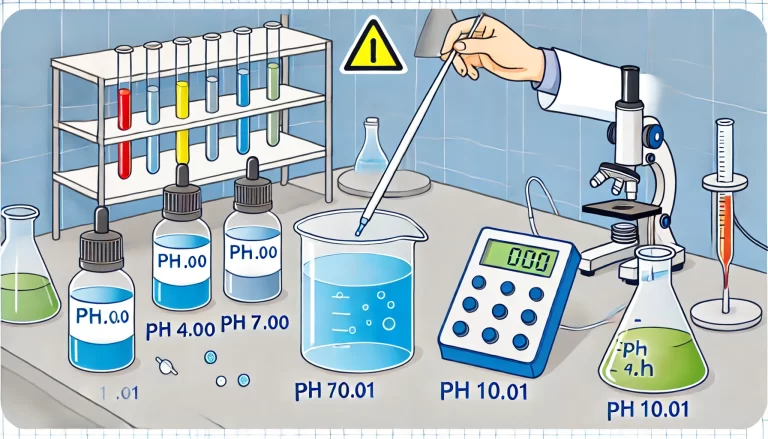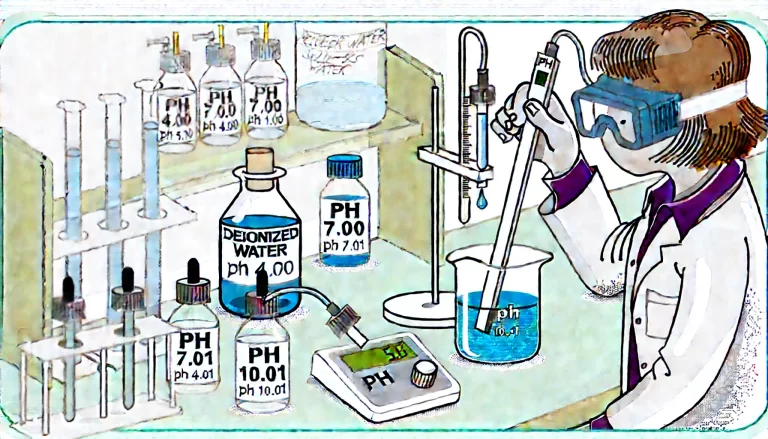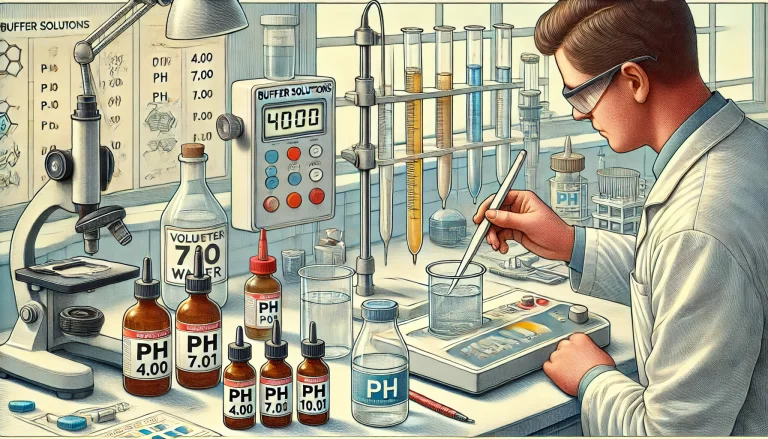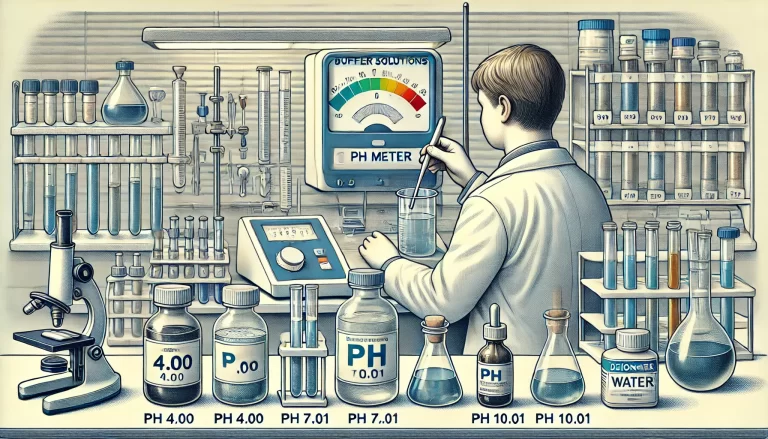A pH meter is primarily used to precisely measure the acidity or alkalinity of a liquid medium. It is a widely used, easy-to-operate, and simple laboratory instrument. However, various problems often occur during its use, such as fluctuating readings, calibration issues, problems with buffer solutions, etc. What are the causes of these issues?
What is a pH Standard Buffer Solution? What are its Characteristics?
A pH buffer solution is a solution that can maintain a stable pH value. When a small amount of acid or alkali is added to this solution, or when a chemical reaction in the solution produces a small amount of acid or alkali, or the solution is diluted, its pH value remains relatively unchanged. A solution that resists small amounts of acid or alkali, or dilution, while keeping the pH value stable is called a buffer solution.
The characteristics of a pH standard buffer solution are as follows:
- The pH value of the standard solution is known and meets the required accuracy.
- The pH value of the standard solution has good reproducibility and stability, with a high buffering capacity, a small dilution effect, and a low temperature coefficient.
- The solution is easy to prepare.

How to Prepare a pH Standard Buffer Solution?
For general pH measurements, a set of pH buffer reagents (enough to prepare 250mL) can be used. When preparing the solution, deionized water should be used, and it should be boiled for 15-30 minutes beforehand to remove dissolved carbon dioxide. Open the plastic bag, pour the reagent into a beaker, dissolve it in an appropriate amount of deionized water, rinse the packaging bag, pour the solution into a 250mL volumetric flask, dilute to the mark, and mix well.
How to Correctly Store and Use pH Buffer Solutions?
After preparation, the buffer solution should be stored in glass bottles or polyethylene bottles (alkaline pH buffer solutions such as pH 9.18, pH 10.01, and pH 12.46 should be stored in polyethylene bottles). The bottle should be tightly sealed and stored in a refrigerator at a low temperature (5-10°C). Generally, the solution can be used for about six months. If turbidity, mold, or precipitation is observed, it should not be used further. When in use, prepare several 50mL polyethylene bottles, pour the buffer solution from the large bottle into the small bottles, and leave them at room temperature for 1-2 hours until the temperature equilibrates before use. After use, do not return the solution to the large bottle to avoid contamination. Buffer solutions stored at temperatures above 10°C can be used for 2-3 days. Solutions like pH 7.00, pH 6.86, and pH 14.00 have a longer shelf life, while pH 9.18 and pH 10.01 solutions tend to change their pH values more easily due to absorbing carbon dioxide from the air.
What are the Uses of pH Buffer Solutions?
- Calibrate pH meters before measurements.
- Verify the accuracy of a pH meter by comparing the reading of the meter with the known pH value of a buffer solution (e.g., using pH 6.86 and pH 14.00 for calibration, then inserting the electrode into a pH 9.18 solution to check if the displayed value matches the standard).
- Check if the pH meter needs recalibration for general precision measurements. After calibration and use, the pH meter may experience drift or changes, so before testing, the electrode should be inserted into a standard buffer solution close to the test solution’s pH to determine if recalibration is necessary based on the error size.
- Test the performance of pH electrodes.

Why Soak pH Electrodes? How to Correctly Soak a pH Composite Electrode?
pH electrodes must be soaked before use because the pH bulb is made of a special glass membrane that forms a thin gel layer on the surface of the glass. This layer must be fully moistened to properly interact with the hydrogen ions in the solution. Additionally, soaking the glass electrode reduces the asymmetric potential and stabilizes it. pH glass electrodes can generally be soaked in distilled water or pH 4.00 buffer solution. The soaking time can vary depending on the thickness of the glass membrane and the degree of electrode aging. Soaking for 24 hours or longer in a pH 4.00 buffer solution is generally more effective.
Moreover, the liquid junction of the reference electrode also needs to be soaked. If the liquid junction dries out, the liquid junction potential will increase or become unstable. The soaking solution for the reference electrode must match the reference electrode’s outer reference solution, which is either 3.3mol/L KCl solution or saturated KCl solution. Soaking for a few hours is usually sufficient.
For pH composite electrodes, soaking in a pH 4.00 buffer solution containing KCl is necessary to simultaneously affect the glass bulb and the liquid junction. It is important to note that in the past, people often soaked pH glass electrodes in deionized water or pH 4 buffer solution, but such practices are not suitable for pH composite electrodes. Some incorrect instructions in pH composite electrode manuals may lead to improper soaking methods, resulting in a slow response or poor accuracy.
Correct soaking methods should be followed, such as preparing a pH 4.00 buffer solution with 56 grams of analytical grade KCl added to 250mL of deionized water, and then stirring until fully dissolved.

Differences Between Rechargeable and Non-Rechargeable pH Composite Electrodes
pH composite electrodes can have plastic or glass housings. Rechargeable pH composite electrodes have a refill hole on the electrode housing, allowing KCl solution to be refilled when the outer reference solution depletes. Non-rechargeable electrodes are filled with gel-like KCl, which does not deplete easily and does not have a refill hole.
Rechargeable electrodes feature higher reference solution permeability, stable junction potential, and higher measurement accuracy. However, they require more maintenance. When using a rechargeable electrode, the refill hole should be opened to increase liquid pressure and accelerate the electrode’s response. The electrolyte should be refilled when the level drops below 2cm from the refill hole.
Non-rechargeable electrodes are easier to maintain and use, making them widely applicable. However, in long-term, continuous use, the KCl concentration at the liquid junction may decrease, affecting measurement accuracy. Therefore, non-rechargeable electrodes should be soaked in electrode soaking solution when not in use to maintain performance for the next test.

How to Properly Use a pH Composite Electrode?
Ensure that there are no air bubbles in the bulb. If air bubbles are present, shake them out with force.
When removing the electrode from the soaking bottle, shake it in deionized water and let it air dry. Do not wipe the bulb with paper towels, as static electricity may transfer charges to the glass membrane, prolonging the time for potential stabilization. A better method is to rinse the electrode with the test solution.
After inserting the pH composite electrode into the test solution, stir gently and then let it rest to accelerate the electrode’s response.
For measurements in viscous samples, rinse the electrode multiple times with deionized water to remove any adhering samples from the glass membrane. In some cases, solvents may be needed to clean off the sample before rinsing with water and re-soaking the electrode to activate it.
Avoid contact with strong acids, strong alkalis, or corrosive solutions. If such solutions are tested, reduce immersion time as much as possible and clean the electrode thoroughly afterward.
Avoid using the electrode in dehydrating media such as anhydrous ethanol or concentrated sulfuric acid, as these will damage the hydrated gel layer on the bulb surface.
